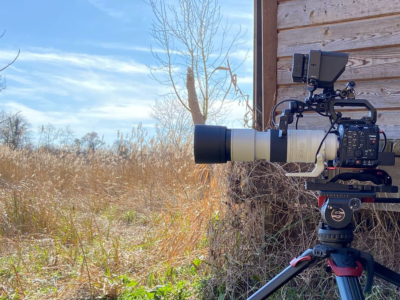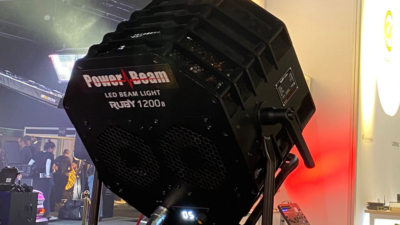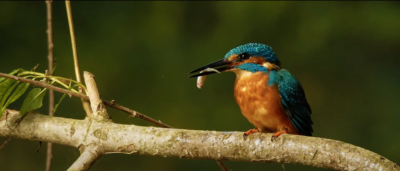![Camerimage 2023 Pauvres Créatures [Poor Things] de Yórgos Lánthimos : corps déviant, esprit d’auteur (fr/eng) - Union des Chefs Opérateurs](https://www.unionchefsoperateurs.com/wp-content/uploads/2023/12/img_3749-1.jpeg)
Pauvres Créatures, du réalisateur Yórgos Lánthimos, ouvrait la compétition principale de cette 31e édition du festival Camerimage où il a remporté deux prix. L’occasion d’offrir une perspective critique et esthétique sur cette œuvre singulière, seconde collaboration entre le réalisateur grec et le directeur de la photographie Robbie Ryan (ISC, BSC).
Le Lion d’Or de la Mostra de Venise, Pauvres Créatures [Poor Things], a ouvert la compétition principale de la 31e édition de Camerimage. Si le film ne remporte, à notre plus grand regret, que la Grenouille de Bronze à Torún, cette comédie noire a gagné le tout nouveau Prix du Public et le cœur des festivalier·e·s, remarquée à chaque projection par sa photographie délirante et haute en couleurs, ses performances de jeu remarquables et la précision chirurgicale de sa réalisation. Découvert en 2009 avec le film Canine (image Thimios Bakatakis), le réalisateur grec Yórgos Lánthimos dirige Emma Stone dans le rôle de Bella Baxter.
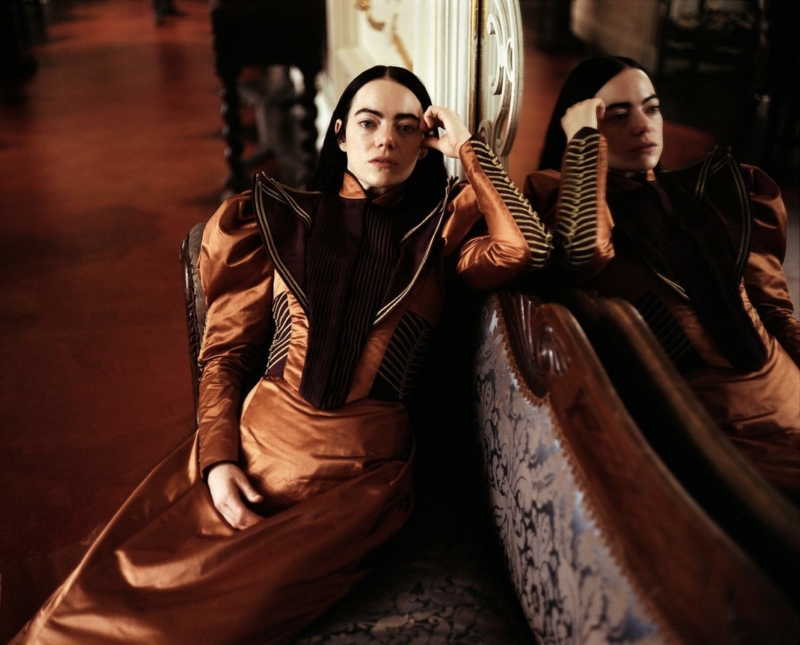
Bella Baxter (Emma Stone) ©2023 Searchlight Pictures All Rights Reserved
L’actrice américaine est désormais habituée à l’exigence du réalisateur, avec qui elle a travaillé en 2019 pour son précédent film La Favorite [The Favourite] et cette seconde collaboration pourrait bien lui décrocher un Oscar. Pour le directeur de la photographie irlandais Robbie Ryan (ISC, BSC), qui signait déjà l’image de La Favorite, il s’agit également de s’inscrire dans une continuité et de permettre au réalisateur de développer par l’image une esthétique caractéristique pour dépeindre son univers singulier et dérangeant.
Adapté il y a plusieurs années du roman éponyme de l’écrivain anglais Alasdair Gray, « Pauvres Créatures » est une odyssée gothique teintée d’humour cynique. Godwin Baxter, un scientifique renommé joué par Willem Dafoe, s’engage secrètement dans une expérimentation inhabituelle : il implante le cerveau d’un bébé dans le corps inerte d’une femme adulte suicidée. De cette greffe insolite naît une créature hérétique : la belle Bella Baxter, initialement puérile et naïve. Bella, assoiffée de découvrir le monde, cherche à fuir cette Angleterre victorienne surréaliste. Lorsqu’elle rencontre le sulfureux avocat Duncan Wedderburn (Mark Ruffalo), elle abandonne Max Candless (Ramy Youssef), choisi par le professeur Baxter pour son étude.
Avec son nouvel amant débauché, Bella se lance dans une aventure qui la mène aux quatre coins du globe. De Lisbonne, où elle explore son corps, à Paris, où elle découvre les bordels et le socialisme, en passant par Alexandrie, cette odyssée philosophique confronte la créature naïve au monde. Lánthimos allie le conte philosophique à la fable gothique pour créer un film singulièrement fascinant.
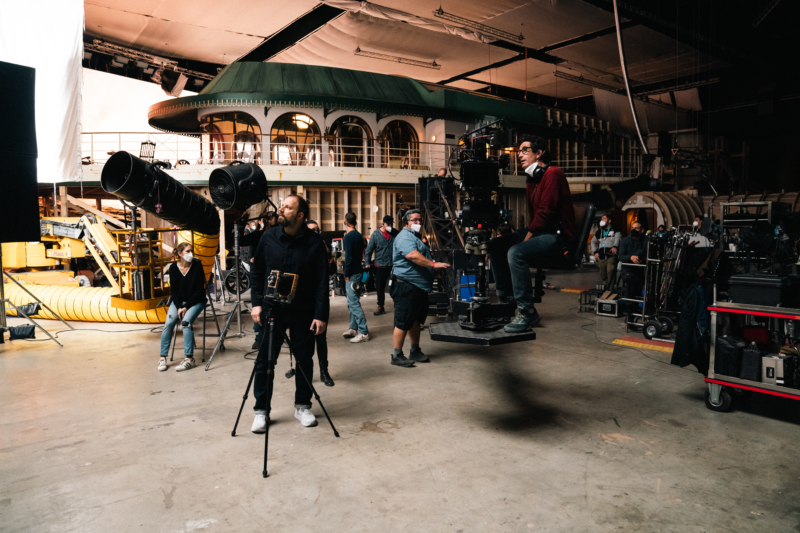
Robbie Ryan derrière la caméra. Crédits : Atsushi Nishijima
CRÉER UN MONDE
Avec Pauvre Créatures, Yórgos Lánthimos ne se contente plus d’accentuer, comme à son habitude, quelques aspects du monde tel que nous le connaissons : il donne naissance à un univers entier.
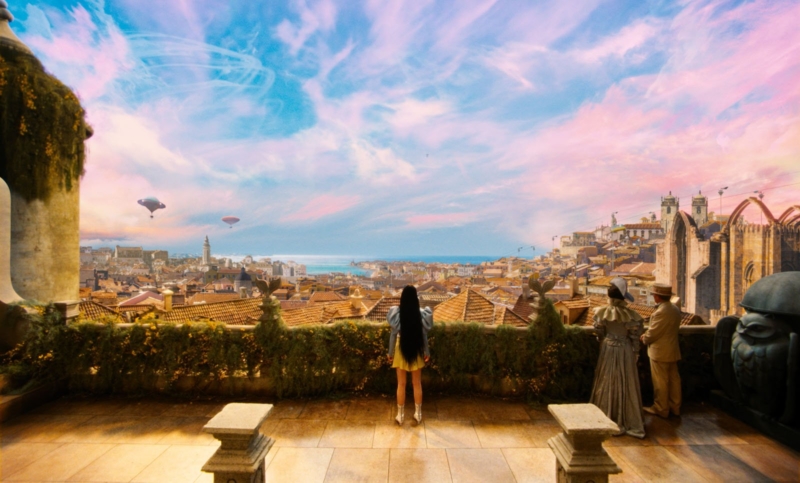
Une vue du Lisbonne de Pauvres Créatures © 2023 Searchlight Pictures All Rights Reserved.
De Canine (2009), où le monde extérieur se devait d’être inexistant, à son précédent film La Favorite (2019), qui avait pour décors un château en Angleterre, le réalisateur grec nous a habitué à des films en apparence sobres et minimalistes, où le drame est contenu, circonscrit. La démesure, plutôt que d’apparaître à l’écran, s’y dévoile dans l’expression exacerbée des affects humains. Pauvres Créatures va à l’encontre de ce principe jusque là essentiel du cinéma Lánthimosien, puisque le scénario ne cantonne plus ses personnages à un espace défini mais transcrit la découverte du monde par Bella Baxter. Et quel monde ! L’odyssée du personnage la conduit à découvrir un espace diégétique qui ressemble au nôtre : c’est comme si ce dernier avait muté après la Révolution Industrielle, devenant cette excroissance farfelue qui emprunte autant au style victorien et à l’Art Nouveau qu’au steampunk, sous-genre de la science fiction qui développe une vision rétro-futuriste du monde où la machine et vapeur et la mécanique sont au coeur du progrès technique. Dans l’Angleterre de Bella, les chiens-poules, les oies-cochons et autres animaux hybrides cohabitent avec les calèches tractées par des chevaux à vapeurs. Exit la sobriété, le croisement de ces différentes esthétiques engendre un espace baroque toujours saturé — saturation d’objets, de texture, de couleurs.
On reconnaîtra les influences de Tim Burton dans l’extravagance des personnages, de Jean-Pierre Jeunet dans l’usage expressif de la couleur ou encore de Terry Gilliam dans la fantaisie des décors. Les extérieurs sont tournés à Paris et Lisbonne. Pour les intérieurs, ce sont les studios Origo de Budapest (Hongrie) qui accueillent durant le mois d’août 2021 les décors conçus pour l’occasion par Shona Heath et James Price.
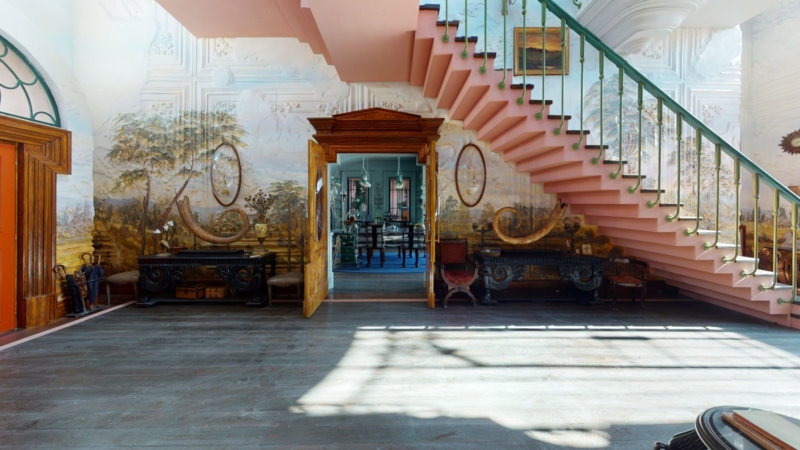
Photographie du décor du manoir. © 2023 Searchlight Pictures All Rights Reserved.
Lánthimos crée un écho démiurgique à la figure du savant fou qui donne naissance — corps — à la protagoniste. Pauvres Créatures est une véritable réinterprétation du mythe de Frankenstein. Mais du monstre, Bella ne conserve que le mécanisme ; bien que sa naissance — création — demeure, en soit, un acte monstrueux, son apparence humaine n’a rien de monstrueux. Au contraire, son corps devient vite objet de désir pour les hommes qui l’entourent, et spécifiquement pour son amant Duncan qui l’arrache au cocon familial. Elle n’hérite guère de l’apparence monstrueuse de son père et créateur, Godwin Baxter, dont le visage protubérant, presque tuméfié, est parcouru de profondes cicatrices. À ce titre le maquillage FX imaginé par Nadia Stacey confère à Willem Dafoe une présence tout à fait singulière.
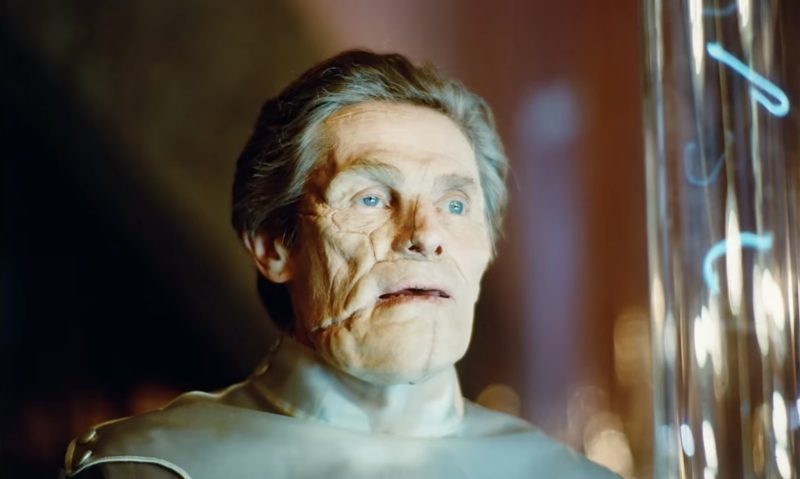
Le visage scarifié de Godbwin Baxter (Willem Dafoe) © 2023 Searchlight Pictures All Rights Reserved.
Son personnage avoue avoir été lui-même le cobaye des expériences de son propre père. Dans l’œuvre originale de Mary Shelley, Victor Frankenstein est le jeune scientifique qui donne naissance au monstre ; dans Pauvres Créatures, c’est le père de Godwin Baxter qui est la figure créatrice originelle, situant ainsi la réinterprétation de Lánthimos une génération après. Si God est le sujet de la première expérimentation F1, alors Bella est le fruit de la seconde génération F2, comme si le nouveau récit faisait tabula rasa des réécritures précédentes du mythe de Frankenstein, soulignant de lui-même l’incroyable caractère contemporain d’un film qui emploie les tropes du récit initiatique.
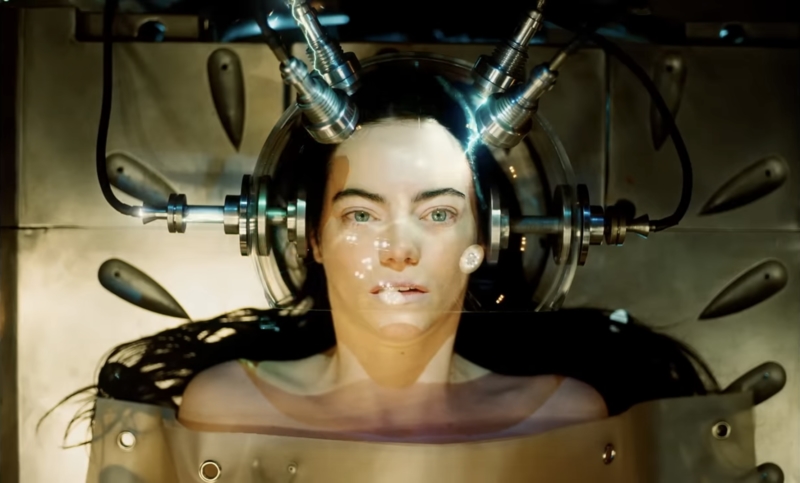
L’expérience « Bella Baxter » (Emma Stone) © 2023 Searchlight Pictures All Rights Reserved.
Comme le monstre de Frankenstein, la figure de Bella, en décalage permanent avec ses semblables, permet de questionner la morale, l’éthique et la nature humaine. Les grands yeux bleus de ce protagoniste-enfant posent sur son monde un regard candide, qui questionne autant les idées d’altérité (la séquence où Bella découvre l’existence de la misère humaine des pauvres d’Alexandrie), de sadisme (la séquence du diner où le militaire prend un malin plaisir à la torture psychologique de ses domestiques) que de l’ordre patriarcal de la société. Cette dernière réflexion est la plus poussée, puisqu’elle parcourt l’ensemble du film. L’exploration du monde et l’émancipation physique, sentimentale et intellectuelle de Bella vont de pair avec sa détermination à se soustraire de l’emprise des figures masculines qui la contraignent constamment.
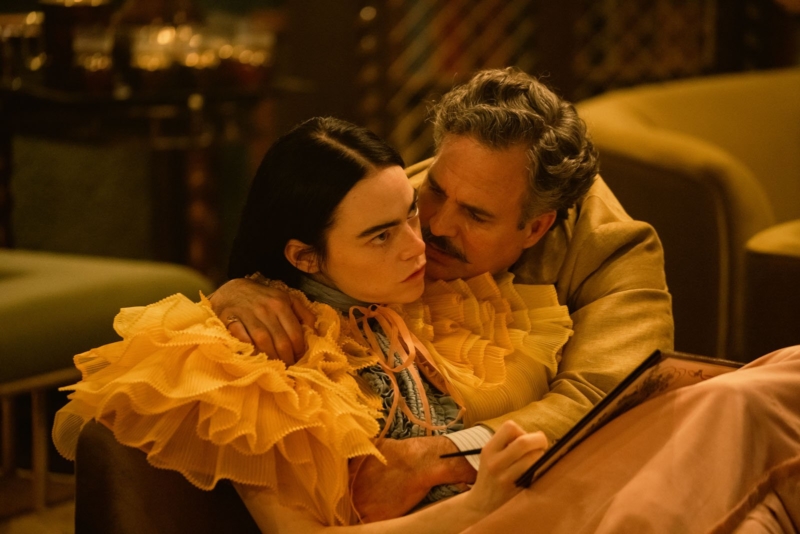
Mark Rufallo dans le rôle de Ducun, l’amant débauché © 2023 Searchlight Pictures All Rights Reserved.
Tous les hommes cherchent à exercer un contrôle sur elle; contrôle sur son corps d’abord, sur le plan purement organique, par son père créateur God ; sur la façon dont ce corps bouge et se comporte en société (la séquence de la libération du corps par la danse est l’une des plus réussie du film) ; contrôle sur la manière dont ce corps peut jouir de son libre-arbitre et de sa liberté de déplacement : elle est d’abord retenu captive par God, puis lorsqu’elle quitte le manoir, c’est son amant Ducan qui cherche à la contraindre (l’exemple le plus parlant étant la séquence où il la drogue, l’enferme dans une malle, avant de la libérer sur un bateau de croisière dont elle n’a bien sûr pas choisi la destination) ; et enfin, contrôle de son plaisir sexuel, de la façon dont son corps même est autorisé à jouir.

Photographie de plateau de la séquence de danse. Crédits : Atsushi Nishijima
Même la trajectoire de Max McCandles, l’amoureux passionné qui s’éprend d’abord d’une femme-enfant qu’il souhaite épouser, permet de questionner l’attrait masculin pour une femme à l’esprit simplet d’une part, et le mariage comme système ou institution qui peut enfermer ou limiter les femmes d’autre part. À l’inverse de Max dont les sentiments semblent les plus sincères, Ducan ne considère autrement Bella que comme un jouet sexuel, et perd de son interêt dès que la femme-enfant développe son esprit et son savoir (“You’re always reading now Bella, you’re losing some your adorable way of speaking.”). La question de l’éveil sexuel de Bella est un élément moteur de la narration. À ce sujet, lors de la séance de questions-réponses (Q&A) qui succède à la projection, une spectatrice souligne la manière avec laquelle le réalisateur est parvenu à montrer, sans pudeur, une femme prenant du plaisir avec son corps, sans pour autant dresser une vision pornographique de la jouissance féminine. Willem Dafoe a répondu que cela avait été grandement facilité par la présence sur le plateau de Elle McAlpine, coordinatrice d’intimité, dont l’apport fut très apprécié.
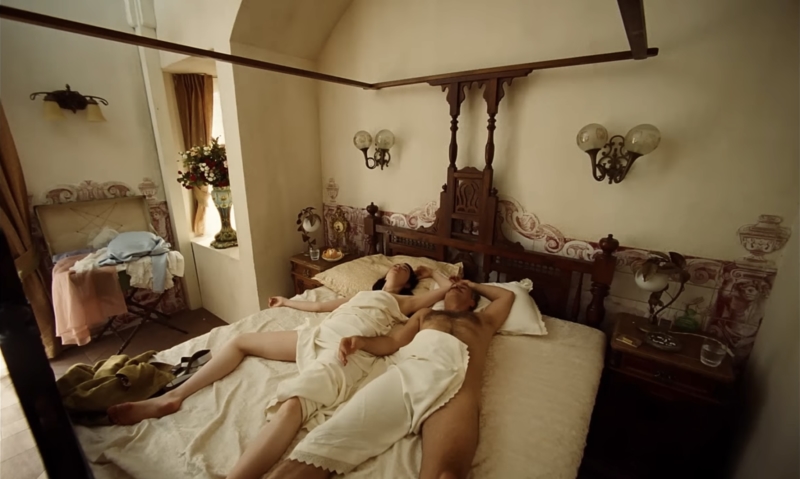
La découverte des plaisirs charnels © 2023 Searchlight Pictures All Rights Reserved.
Bella, créée de toutes pièces dans le grand manoir victorien de Godwin, fait ses premiers pas à l’écran dans le couloir de l’entrée de la demeure. Cependant, c’est dans le jardin qu’elle apparaît pour la dernière fois. Ce jardin dépasse son rôle de simple espace vert pour se transformer en un lieu symbolique, notamment lorsqu’il devient le décor de la dernière séquence du film. C’est ici que Bella achève ses pérégrinations et conclut son histoire.
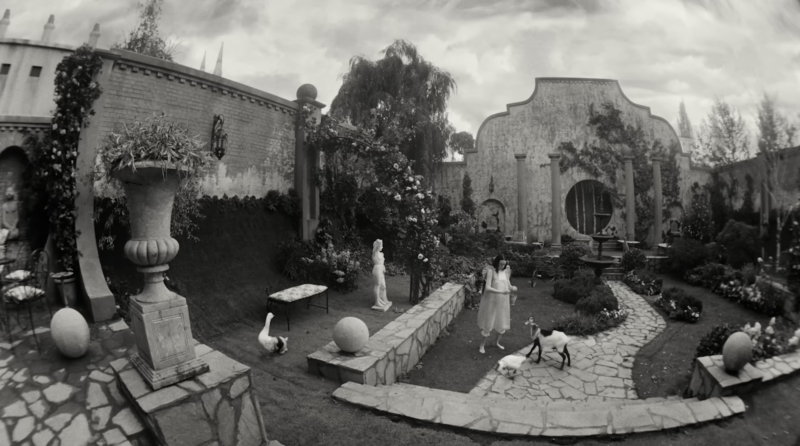 |
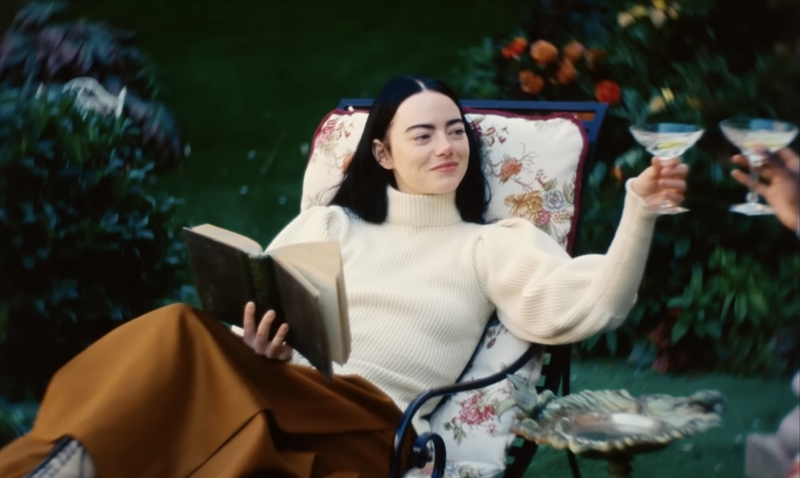 |
Pour renforcer l’évocation du mythe biblique du jardin d’Éden, Lánthimos a nommé son personnage créateur Godwin Baxter, permettant ainsi à Bella de le surnommer, comme il se doit, “God” (qui se prononce comme “Dieu” en anglais) tout au long du film. À l’instar d’un Ingénu ou d’un Candide de Voltaire, « Pauvres Créatures » s’apparente à un conte philosophique.
Les épreuves traversées par Bella lui permettent de développer sa connaissance et de découvrir la philosophie à travers ses lectures, tout en questionnant des thèmes universels tels que la nature humaine, la morale, l’éthique et l’organisation de la société. Le film débute par une scène d’eaux tumultueuses et se termine par un plan d’un livre ouvert dans le jardin du manoir.
La “créature” de God a transformé le chaos du monde en connaissance, et ce dernier plan pourrait parfaitement illustrer la conclusion voltairienne : « Il faut cultiver son jardin ». Ce, malgré le cynisme et la désillusion qui accompagnent le savoir. Parallèlement, Yórgos Lánthimos conclut un film où il a amené sa caméra — plutôt que sa plume — à son apogée, affirmant ainsi un langage cinématographique qui lui est propre.

Bella sur le bateau © 2023 Searchlight Pictures All Rights Reserved.
CRÉER UN LANGAGE
À la manière d’un conte, Pauvres Créature est divisé en chapitres qui épousent la progression de la quête initiatique de sa protagoniste. Lánthimos ne se contente pas d’emprunter cette division narrative à la littérature ; il s’emploie, à l’image de Bella qui se dote du langage, à développer un véritable langage filmique.
Depuis La Favorite, la grammaire Lánthimosienne a gagné en richesse et en style, poussant d’un cran les expérimentations visuelles entreprises par le réalisateur et son directeur de la photographie dans La Favorite. « Yórgos déteste l’idée d’un découpage technique conventionnel », confie Robbie Ryan. Le film alterne constamment entre deux extrêmes : des gros plans sur les visages, souvent pris en dessous du menton avec une longue focale, qui isolent les personnages, et des plans en très grand angle. « Nous avons conçu les scènes avec divers mouvements de dolly et de grue, débutant par exemple sur un gros plan, puis élargissant le champ pour suivre un autre personnage, et pouvant même intégrer un plan extrêmement large. » Le lien entre ces extrêmes est le zoom, que le réalisateur voulait incorporer dans le langage visuel du film. « Techniquement, intégrer autant de zooms dans la composition visuelle était un défi pour moi », admet le directeur de la photographie. Capable de passer, sans coupure, d’un gros plan sur un visage à un plan général du décor. « Yórgos cherchait quelque chose d’optiquement très ambitieux, malheureusement irréalisable ». Cependant, le directeur de la photographie a finalement opté pour le Zeiss Master Zoom 16.5mm – 110mm.

Crédits : PhotoCineRent
Pour l’ensemble du film, il a utilisé une combinaison de différentes optiques Nikon, Optimo Angénieux et Zeiss Master Prime (que le groupe Transmission de l’UCO a eu l’occasion d’apprécier lors d’une journée de test comparatif en octobre dernier), ainsi que des optiques vintages 58mm et 85mm Petzval au bokeh circulaire caractéristique.

Crédits : UV
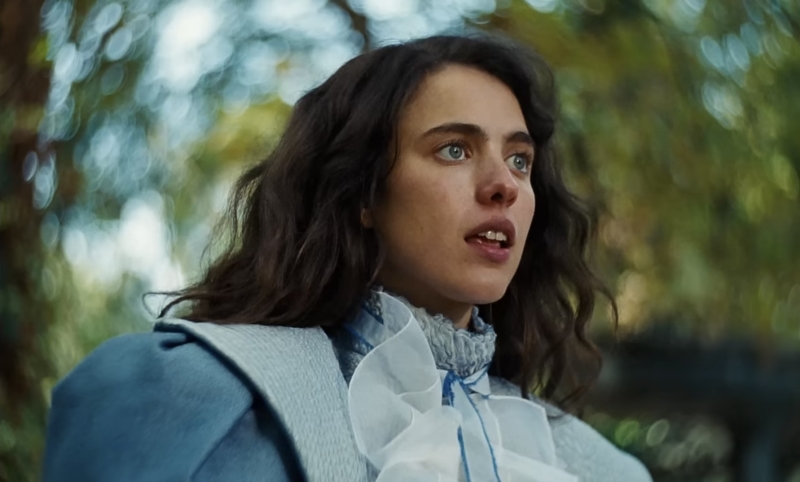
Le bokeh circulaire des optiques Petzval © 2023 Searchlight Pictures All Rights Reserved.
Pour les ultra grands-angles, le directeur de la photographie a utilisé une optique PL Optex 4mm T2. Ainsi, l’emploi caractéristique de l’ultra grand-angle, s’affirme dans ce film. Elle fait presque passer son utilisation dans La Favorite comme anecdotique, tant son usage est ici poussé à l’extrême, quitte à ne pas recouvrir toute la zone d’impression de la pellicule. L’Optex 4mm, conçu pour couvrir du 16mm ou du S16mm, n’est initialement pas prévu pour couvrir le 35mm 4 perforations retenu pour tourner le film, « mais il donne un charmant vignettage avec des contours noirs, comme une sorte de hublot vers un autre monde, défini au centre, avec une diminution progressive de la netteté vers l’extérieur, que Yorgos a vraiment apprécié. »
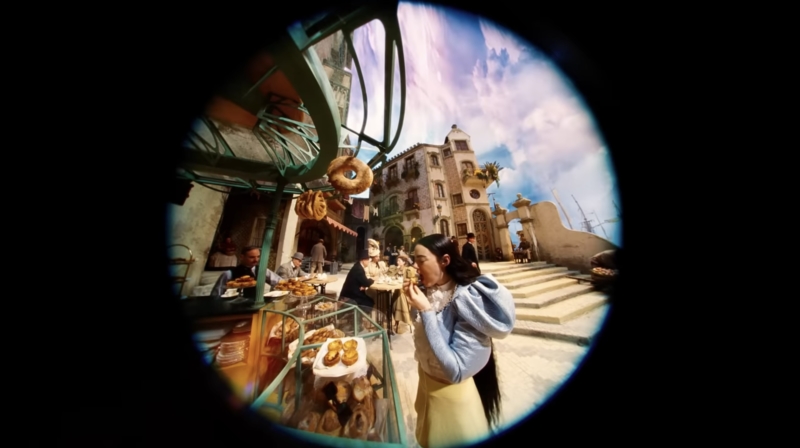
L’Optex 4mm conçu pour la pellicule 16mm sur du 35mm © 2023 Searchlight Pictures All Rights Reserved.
Et pour ne pas avoir de pieds de projecteur dans l’angle de champ, qui peut, à tout moment, être très large, R. Ryan opte pour une lumière douce et diffuse, avec beaucoup de lumières praticables dans le décor. « J’ai probablement utilisé tous les Skypanels de Budapest » ironise-t-il lors de la séance de Q&A. Pourtant jamais l’image n’est ennuyante, tant elle est constamment fournie, expressive, saturée et organique; et doit beaucoup au choix de tourner en pellicule Kodak Ektachrome. Les couleurs sont riches et vibrantes, les noirs denses et contrastés, tandis que les ton chairs restent fidèles.

Une photographie BTS du studio © 2023 Searchlight Pictures All Rights Reserved.
Pauvres Créature est le premier film de cette envergure à utiliser le 35mm Kodak Ektachrome, émulsion positive (diapositive) développée en processus inversif via le procédé E-6. Le fabricant à en effet ré-introduit sa célèbre émulsion en 2018, d’abord en 16mm et Super 16mm, avant de la produire en 35mm en 2021. À l’exception de la première séquence en couleur, la première partie du film est entièrement en noir et blanc; un choix tardif du réalisateur, qui a dû convaincre les producteurs du film. Robbie Ryan confesse néanmoins que ce premier segment en couleur vise à capter l’attention du publique avant de tomber dans ce noir et blanc contrasté.
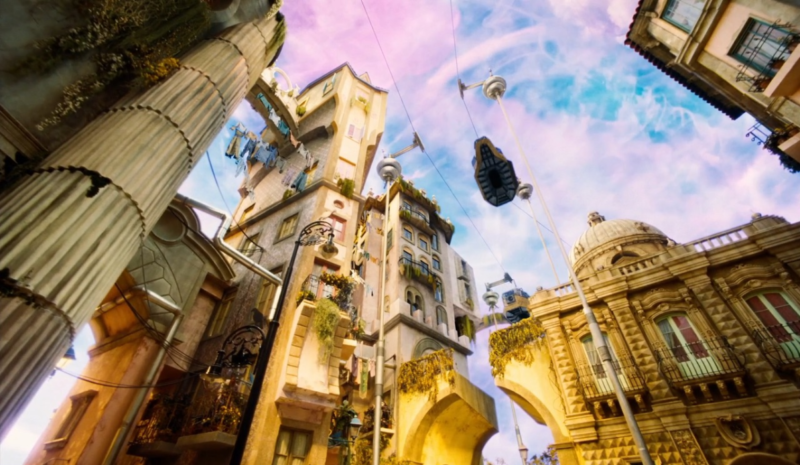
Image finale © 2023 Searchlight Pictures All Rights Reserved.
Le passage à la couleur avec l’émulsion Kodak Ektachrome 100D 5294, puis la Kodak Vision3 500T 5219 pour le dénouement du film, succède à la beauté froide et granuleuse de l’émulsion N&B Kodak Double-X 5222 que Ryan a choisie. Ce changement fait sens : le contraste manichéen du noir et blanc, de l’intérieur et de l’extérieur, de la captivité et de la liberté, n’ont plus lieu d’être pour explorer et découvrir la richesse du monde. Bella « met de la couleur dans un monde en noir et blanc » ajoute Ryan après la projection.

Bella dans le manoir. Copyright 2023 Searchlight Pictures All Rights Reserved.
Au-delà de la grammaire filmique traditionnelle attendue d’une grosse production américaine (avec un budget de 35 mio de $), la caméra de Lánthimos se distingue par son caractère incarné. Les zooms, les panoramiques, les mouvements dans l’espace, bien que pas toujours parfaitement exécutés, révèlent la présence de l’opérateur derrière la caméra. On peut toutefois regretter l’absence d’évolution de cette grammaire filmique au sein du film, qui aurait pu se diversifier davantage, au-delà de l’usage soudain de la couleur, parallèlement au développement intellectuel de Bella. Emma Stone interprète son personnage avec brio, adaptant l’aisance de son corps, ses mimiques et ses expressions au fil de l’évolution de son personnage. Comment le réalisateur grec dirige-t-il ses acteurs et actrices ? Quelle liberté leur accorde-t-il ? « Il ne sait pas exactement ce qu’il veut mais il connaît le dispositif [de la séquence]. Il crée un univers, et tu te déplaces à l’intérieur » répond Willem Dafoe après la projection. « C’est l’univers qui te guide. » Et Robbie Ryan de compléter sur le mode opératoire sur le plateau : Lánthimos dispose de tous les outils de tournage — tous les éléments de son langage cinématographique. C’est en observant la scène s’animer sous ses yeux, à travers le jeu des acteurs, que le réalisateur, avec son acuité habituelle, décide où focaliser son attention.
La caméra agit comme un scalpel, qui tranche avec dextérité. « Pour Yorgos c’est un pas dans une nouvelle direction. Il se challenge lui-même et ça se voit. Il est précis. » déclare Ryan lors du Q&A. Le réalisateur de La Favorite a utilisé la reconnaissance critique de ce précédent film pour perfuser son style dans une production avec un budget conséquent. Lanthimos accouche d’un véritable objet de cinéma, une création singulière qui ne laisse pas indifférent·e. Elle sera un jalon de plus dans la continuité de l’œuvre du cinéaste et sans doute une porte d’entrée vers les autres films de l’auteur. La greffe est réussie.
____
🇬🇧 English version
Poor Things directed by Yórgos Lánthimos, opened the main competition at this 31st edition of the Camerimage festival, where it won two prizes. This is an opportunity to offer a critical and aesthetic perspective on this singular work, the second collaboration between the Greek director and cinematographer Robbie Ryan (ISC, BSC).
Poor Things, the Golden Lion winner at the Venice Film Festival, opened the main competition at the 31st edition of Camerimage. Although, to our great regret, the film only won the Bronze Frog at Torún, this black comedy won the brand new Audience Award and the hearts of festival-goers, noted at every screening for its deliriously colourful photography, remarkable acting performances and surgically precise direction. Discovered in 2009 with the film Canine (image Thimios Bakatakis), Greek director Yórgos Lánthimos directs Emma Stone in the role of Bella Baxter.

Bella Baxter (Emma Stone) ©2023 Searchlight Pictures All Rights Reserved
The American actress is now used to the director’s rigorous standards, having worked with him in 2019 on his previous film The Favourite, and this second collaboration could well win her an Academy Award. For Irish cinematographer Robbie Ryan (ISC, BSC), who already shot The Favourite, it’s also a question of continuity and allowing the director to use his images to develop a characteristic aesthetic to depict his singular and disturbing world. Adapted several years ago from the novel of the same name by English writer Alasdair Gray, Poor Creatures is a Gothic odyssey with a cynical sense of humour. Godwin Baxter, a renowned scientist played by Willem Dafoe, carries out a bizarre experiment in the greatest secrecy: he implants the brain of a baby into the hitherto inert body of an adult woman who has taken her own life. The result of this far-fetched transplant is a heretical creature: the beautiful Bella Baxter, initially childish and naive. But Bella has a thirst for the world and is desperate to escape this surreal Victorian England. When the ingenue meets the sultry lawyer Duncan Wedderburn (Mark Ruffalo), she leaves behind Max Candless (Ramy Youssef), appointed by Professor Baxter to take part in his study. Bella embarks with her debauched new lover on an adventure that takes her to the four corners of the globe. From Lisbon, where she explores her body, to Paris, where she discovers brothels and socialism, via Alexandria, this philosophical odyssey confronts the candid creature with the world. Lánthimos borrows as much from the philosophical tale as from the gothic fable to produce a strangely fascinating film.

Robbie Ryan behind the camera. Credits: Atsushi Nishijima
CREATE A WORLD
With Poor Things, Yórgos Lánthimos is no longer content, as usual, to accentuate a few aspects of the world as we know it: he gives birth to an entire universe.

A view of Lisbon from Poor Creatures © 2023 Searchlight Pictures All Rights Reserved.
From Dogtooth (2009), in which the outside world was supposed to be non-existent, to his previous film The Favorite (2019), set in a castle in England, the Greek director has accustomed us to films that are apparently sober and minimalist, in which the drama is contained and circumscribed. Rather than appearing on screen, excess is revealed in the heightened expression of human emotions. Poor Creatures goes against this essential principle of Lánthimosian cinema, since the script no longer confines its characters to a defined space but transcribes Bella Baxter’s discovery of the world. And what a world it is! The character’s odyssey leads her to discover a diegetic space that resembles our own: it’s as if the latter had mutated after the Industrial Revolution, becoming this eccentric outgrowth that borrows as much from Victorian style and Art Nouveau as from steampunk, a sub-genre of science fiction that develops a retro-futuristic vision of the world in which steam engines and mechanics are at the heart of technical progress. In Bella’s England, hound dogs, pig geese and other hybrid animals live alongside horse-drawn steam carriages. The intersection of these different aesthetics creates a baroque space that is always saturated – saturation of objects, textures and colours.
You’ll recognise the influences of Tim Burton in the extravagance of the characters, Jean-Pierre Jeunet in the expressive use of colour and Terry Gilliam in the fantasy of the sets. The exteriors were shot in Paris and Lisbon. For the interiors, the Origo studios in Budapest (Hungary) will host the sets designed for the occasion by Shona Heath and James Price during August 2021.

Photograph of the mansion set © 2023 Searchlight Pictures All Rights Reserved.
Lánthimos creates a demiurgic echo to the figure of the mad scientist who gives birth – body – to the protagonist. Poor Things is a veritable reinterpretation of the Frankenstein myth. But Bella retains only the mechanism of the monster; although her birth – creation – remains a monstrous act in itself, there is nothing monstrous about her human appearance. On the contrary, her body quickly becomes an object of desire for the men around her, and specifically for her lover Duncan, who tears her away from the family cocoon. She hardly inherits the monstrous appearance of her father and creator, Godwin Baxter, whose protruding, almost swollen face is criss-crossed with deep scars. The FX make-up designed by Nadia Stacey gives Willem Dafoe a very special presence.

The scarred face of Godbwin Baxter (Willem Dafoe) © 2023 Searchlight Pictures All Rights Reserved.
His character admits that he himself was the guinea pig for his own father’s experiments. In Mary Shelley’s original work, Victor Frankenstein is the young scientist who gives birth to the monster; in Poor Creatures, it is Godwin Baxter’s father who is the original creative figure, thus situating Lánthimos’s reinterpretation a generation later. If God is the subject of the first F1 experiment, then Bella is the fruit of the second F2 generation, as if the new story were making a tabula rasa of previous rewrites of the Frankenstein myth, underlining the incredibly contemporary nature of a film that employs the tropes of the initiation story.

The « Bella Baxter » experience (Emma Stone) © 2023 Searchlight Pictures All Rights Reserved.
Like Frankenstein’s monster, the figure of Bella, constantly at odds with her fellow human beings, allows us to question morality, ethics and human nature. The big blue eyes of this child protagonist cast a candid gaze on her world, questioning the ideas of otherness (the sequence in which Bella discovers the existence of the human misery of the poor of Alexandria), sadism (the dinner sequence in which the soldier takes malicious pleasure in the psychological torture of his servants) and the patriarchal order of society. This last reflection is the most far-reaching, running through the entire film. Bella’s exploration of the world and her physical, emotional and intellectual emancipation go hand in hand with her determination to escape the grip of the male figures who constantly constrain her.

Mark Rufallo as Ducun, the debauched lover © 2023 Searchlight Pictures All Rights Reserved.
All the men seek to exert control over her; control over her body first of all, on a purely organic level, by her creator father God; control over the way this body moves and behaves in society (the sequence of the liberation of the body through dance is one of the most successful in the film); control over the way this body can enjoy its free will and freedom of movement: First she is held captive by God, then when she leaves the mansion, it is her lover Ducan who seeks to coerce her (the most telling example being the sequence where he drugs her, locks her in a trunk, before releasing her on a cruise ship whose destination she has of course not chosen); and finally, control over her sexual pleasure, over the way her very body is allowed to enjoy.

Set photograph of the dance sequence. Credits: Atsushi Nishijima
Even the development of Max McCandles, the passionate lover who first falls in love with a woman-child whom he wishes to marry, allows us to question the male attraction to a woman with a simple mind on the one hand, and marriage as a system or institution that can confine or limit women on the other. Unlike Max, whose feelings seem the most sincere, Ducan otherwise sees Bella as little more than a sex toy, and loses interest as soon as the child-woman develops her wit and knowledge (« You’re always reading now Bella, you’re losing some your adorable way of speaking. »). The question of Bella’s sexual awakening is a driving force in the narrative. During the Q&A session following the screening, a viewer commented on the way the director had managed to show a woman taking pleasure with her body without being shy, without presenting a pornographic vision of female pleasure. Willem Dafoe replied that this was largely possible thanks to the much-appreciated presence on the set of Elle McAlpine, the intimacy coordinator.

The discovery of fleshly pleasures © 2023 Searchlight Pictures All Rights Reserved.
Bella is created from scratch in God’s grand Victorian mansion, and although she takes her first steps on screen in the entrance hall, it is in the garden that she appears for the last time. The garden is no longer just a garden. It becomes a symbolic space when it serves as the setting for the film’s final sequence, where Bella ends her wanderings and brings the story to a close.
 |
 |
To complete this evocation of the biblical myth of the Garden of Eden, Lánthimos names the creative figure Godwin Baxter, allowing Bella to appropriately refer to him as « God » throughout the film. Like Voltaire’s Ingénu or Candide, Pauvres Créatures operates on the same principle as a philosophical tale, in which the various trials Bella undergoes enable her to develop her knowledge and discover philosophy through her reading, as well as being a means of questioning universal themes such as human nature, morality, ethics and the organisation of society. The film opens with a shot of tumultuous waters and closes with a shot of an open book in the garden of the manor house. God’s ‘creature’ has organised the chaos of the world into knowledge, and this last shot could be the perfect illustration of Voltairien’s conclusion « You have to cultivate your garden ». And this despite the cynicism and disillusionment with the world that comes with knowledge. At the same time, Yórgos Lánthimos concludes a film in which he has pushed his camera – since it cannot be his pen – to the limit, asserting a cinematic language all his own.

Bella on the boat © 2023 Searchlight Pictures All Rights Reserved.
CREATING A LANGUAGE
Like a fairy tale, Poor Creature is divided into chapters that follow the progression of its protagonist’s quest for initiation. But Lánthimos is not content to borrow this narrative division from literature; like Bella, who acquires language, he sets out to develop a genuine filmic language.
Since The Favourite (2019), Lánthimosian grammar has become richer and more stylistic, taking the visual experimentation undertaken by the director and his cinematographer in La Favorite a step further. « Yórgos hates the idea of an academic technical breakdown, » explains Robbie Ryan. Indeed, there is a constant alternation between two extremes. Close-ups of the faces, often below the chin, in long focus, isolating the characters, and very wide angle shots. « We […] cut the scenes with different dolly and crane movements, which, for example, start with a close-up, zoom out and then follow another character, and may even be interspersed with an extremely wide shot ». The binding material between these two extremes is the zoom, which the director wanted to introduce into the film’s cinematographic language: « Technically, integrating so many zooms into the plasticity of the visual narrative was something new for me », admits the director of photography. Able to go from a close-up of a face to an overall shot of the set without cutting. « Yórgos wanted something that was optically really, really impossible, unfortunately. But in the end the director of photography opted for the Zeiss Master Zoom 16.5mm – 110mm.

Credits : PhotoCineRent
For the entire film, he used a combination of different Nikon, Optimo Angénieux and Zeiss Master Prime lenses (which the UCO Transmission group had the opportunity to appreciate during a comparative test day last October), as well as vintage 58mm and 85mm Petzval lenses with their characteristic circular bokeh.

Credits : UV

The circular bokeh of Petzval lenses © 2023 Searchlight Pictures All Rights Reserved.
For the ultra-wide angles, the director of photography used a PL Optex 4mm T2 lens. In this way, the characteristic use of the ultra-wide-angle lens is asserted in this film. It almost makes its use in The Favourite seem anecdotal, so extreme is its use here that it does not even cover the entire print area of the film. The Optex 4mm, designed to cover 16mm or S16mm, was not initially intended to cover the 35mm 4 perforations chosen to shoot the film, « but it gives a charming vignetting with black outlines, like a sort of porthole to another world, defined in the centre, with a gradual decrease in sharpness towards the outside, which Yorgos really appreciated ».

The Optex 4mm designed for 16mm film on 35mm film © 2023 Searchlight Pictures All Rights Reserved.
And to avoid having spotlight stands in the angle of view, which can be very wide at any time, R. Ryan opts for soft, diffused lighting, with lots of walkable lights in the set. « I’ve probably used every Skypanel in Budapest, » he quipped during the Q&A session. Yet the image is never boring, so constantly full, expressive, saturated and organic; and owes much to the choice of shooting on Kodak Ektachrome film. Colours are rich and vibrant, blacks dense and contrasty, while flesh tones remain faithful.

A BTS photograph of the studio © 2023 Searchlight Pictures All Rights Reserved.
Poor Creature is the first film of this scale to use 35mm Kodak Ektachrome, a positive emulsion (reversal film) developed using the E-6 process. The manufacturer reintroduced its famous emulsion in 2018, first in 16mm and Super 16mm, before producing it in 35mm in 2021. With the exception of the first colour sequence, the first part of the film is entirely in black and white; a late choice by the director, who had to convince the film’s producers. Nevertheless, Robbie Ryan confesses that this first colour segment was intended to capture the audience’s attention before falling into this contrasting black and white.

Final image © 2023 Searchlight Pictures All Rights Reserved.
The switch to colour with the Kodak Ektachrome 100D 5294 emulsion, then the Kodak Vision3 500T 5219 for the film’s denouement, follows the cold, grainy beauty of the B&W Kodak Double-X 5222 emulsion that Ryan chose. This change makes sense: the Manichean contrast of black and white, of inside and outside, of captivity and freedom, are no longer needed to explore and discover the richness of the world. Bella « brings colour to a black and white world », adds Ryan after the screening.

Bella in the mansion. Copyright 2023 Searchlight Pictures All Rights Reserved.
Beyond the academic film grammar one might expect from such a large American production (with a budget of 35 mio $), Lánthimos’s camerawork is very much embodied. The zooms, pans and movements of the camera in space, not always perfectly executed, all contribute to this revelation of the presence of the operator behind the camera. However, it is regrettable that this grammar does not evolve within the film itself, which could have been enriched by more than just the sudden use of colour, in line with Bella’s intellectual development. Emma Stone embodies her character remarkably well, adapting the ease of her body, her facial expressions to the development of her character. How does the Greek director direct his actors? How much space does he give them? « He doesn’t know exactly what he wants, but he knows the set-up [of the sequence]. He creates a world, and you evolve within it, » replies Willem Dafoe after the screening. « It’s the world that tells you what to do. And Robbie Ryan explains the modus operandi on the set: Lánthimos has all the tools of the trade – all the words in his language – on the set. It is by watching the sequence come to life before his eyes, through acting, that the director, with his customary acuity, chooses where to focus his attention.
The camera acts like a scalpel, cutting with dexterity. « For Yorgos, it’s a step in a new direction. He challenges himself and it shows. He’s precise, » says Ryan in the Q&A. The director of La Favorite has used the critical acclaim of his previous film to infuse his style into a production with a substantial budget. Lanthimos has produced a true object of cinema, a singular creation that leaves no one indifferent. It will be another milestone in the continuity of the filmmaker’s work and undoubtedly a gateway to his other films. The transplant is a success.
-
Partager l'article
